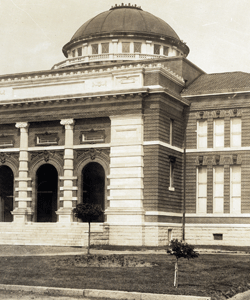Today, the libraries at Duke University are a hive of activity: As a space for reading, research, data analysis, the digital humanities, and socializing, the library is the heart of campus to many in the Duke community. When the institution was first formed, however, this central feature of today’s campus was absent. In fact, it would take decades for the library to occupy a place of prominence.
Although mentioned in the 1840 minutes of Duke’s long-ago predecessor, Union Institute, no library was created at the outset of the school’s opening. Creative students decided to fill the gap through the formation of two literary societies, the Columbian, organized in 1846, and the Hesperian, established in 1851. Each organization had its own library, as well as a student librarian to track the books. The collections were gathered mostly through donations, and a small number of purchases. The literary society collections were available only to their own members and faculty. By 1861, each society had 2,200 volumes, and a general college library of 650 titles was available for all students of the newly renamed Trinity College.
By 1887, when President John Franklin Crowell arrived from Yale, it was clear that something needed to change. Crowell suggested merging all the libraries—those belonging to literary societies and the general college library—into one centralized collection of about 10,000 volumes. In recognition of his influence, and perhaps lending credence to the saying, “no good deed goes unpunished,” Crowell was elected “librarian-in-chief.” He embraced the role, and wrote: “It has created a new era in the history of the College. Not only has instruction been increased in effectiveness, but the extraordinary interest shown by students in their work individually is going to be one of the best advertisements for the College we could have made.” It was said that the president personally spent an hour a day answering reference questions (this practice does not continue today). Passionate about the cause, Crowell even spent one Christmas holiday studying other East Coast libraries for ideas.
Not surprisingly, Crowell could not keep up his librarian duties as well as spearhead the college’s 1892 move from Randolph County to Durham. A new professor, Stephen B. Weeks, arrived in 1891; he was named librarian and chairman of the Reading Room Committee, which were unpaid duties in addition to his faculty work. Nevertheless, he actively sought to make Trinity into a center of scholarly study for North Carolina and Southern history. An article by Weeks called “The Renaissance: A Plea for the Trinity College Library” ran in many publications across the state and called for a “library strong in historical materials…. We need missionaries to go from house to house for us in a search for these scattered but precious documents and papers.” Here, we see evidence of the very beginning of the Rubenstein Rare Book & Manuscript Library at Duke. Donations of materials began to pour in.
Weeks left after a couple of years, and the role of librarian was largely fulfilled by student workers. The other improvements he had suggested were likewise neglected due to lack of funding.
This changed in 1898. Joseph P. Breedlove, Class of 1898, was appointed librarian. Without any formal training in librarianship, Breedlove was sent by then-President John C. Kilgo to be educated in the practice at Amherst College. Kilgo repeatedly stated that the library “is the one department that measures the future development of the College,” and he was willing to invest in the training of his first professional librarian.
Soon after, in the summer of 1900, James Buchanan Duke agreed to build a library that could hold 100,000 volumes, and he included $10,000 for books—his first gift to the school. The new library was completed in December 1902. Breedlove wrote about the transfer of materials in his history of the libraries, and his frustration at the outcome is evident. Writing in a rather coy third-person, he recalled, “The librarian wanted to stay on the campus and supervise the moving, but President Kilgo insisted that he take his Christmas vacation and he, the president, would supervise the moving.” It seemed President Kilgo did indeed move a small number of books, but then decided to go hunting and put his superintendent of grounds in charge. Breedlove and Professor John Spencer Bassett, who had long been involved in supporting the library, spent three days and nights desperately trying to restore order.
At the February 1903 dedication of the building, journalist, editor, and publisher Walter Hines Page delivered a message from James B. Duke, who was in New York. Page reported that Duke had stated, simply, “Tell every man to think for himself.” And at last, the school had a purpose- built, dedicated library. It has since grown from fewer than 40,000 volumes in 1903 to nearly 7 million today. New libraries have been added, and older ones are updated, such as the planned expansion and renovation of Lilly Library. The collections and spaces enjoyed today are built upon an early foundation of creativity, innovation, and enthusiasm for how a library can transform a campus.


Share your comments
Have an account?
Sign in to commentNo Account?
Email the editor